The UK government’s latest legislative proposal—the DWP Welfare Reform Bill—has become the focus of widespread public discussion. This bill is not just another routine policy adjustment; it represents a major overhaul of the welfare system, particularly targeting Universal Credit and disability benefits. One of the most talked-about aspects is the rumored £725 payout to households, which has raised both hope and confusion among millions.
This article explores what the DWP welfare reform truly means, who stands to benefit, and who may face challenges ahead. We break down the proposed changes, what they mean for different groups, and how they could affect your financial situation over the coming years.
DWP Welfare Reform
The core of the DWP welfare reform is about modernizing how welfare support is delivered while balancing public spending. Though headlines may suggest a large one-time payout of £725 to 7 million households, the reality is more nuanced. This payout is part of a phased Universal Credit boost for specific claimant groups. Meanwhile, there are significant shifts in the structure and accessibility of disability benefits, raising concern among support groups and charities. Universal Credit will rise gradually until it reaches an extra £725 per year, while benefits like LCWRA and PIP face freezes and stricter eligibility. Understanding this duality is essential for anyone trying to navigate the changes or fact-check bold claims.
Overview Table
| Benefit/Policy | Planned Change | Target Group |
| Universal Credit Increase | Gradual rise totaling £725 annually by 2029–30 | Single claimants aged 25+ |
| Annual Uprating | Above-inflation increases between 2.3% and 4.8% yearly | 6.7 million UC households |
| LCWRA (Disability Support) | Frozen for existing; reduced for new claimants from April 2026 | Individuals with limited work capability |
| PIP Qualification Tightening | Stricter scoring and assessments | Disabled individuals and those with mental health issues |
| Carer’s/PIP Run-on | 13-week continued support after change in eligibility | Carers and PIP recipients |
| Severely Ill Exemptions | No reassessments for terminally or severely ill | ~200,000 claimants |
The Truth Behind the £725 Payout
Many are expecting a direct £725 cheque due to misleading posts online, but in reality, the amount is a gradual increase in Universal Credit. It begins in April 2026 and builds year-on-year until the full £725 annual rise is realized by the 2029/30 financial year. It is designed to support single claimants over the age of 25, rather than the entire Universal Credit population.
While the initial rollout will be limited, the uplift is projected to affect approximately 4 million households, not the 7 million widely cited. These households will see incremental increases through annual adjustments above inflation rates.
What Does This Mean for You?
The increase aims to ease the financial pressure on lower-income single adults. It’s part of a broader plan to align welfare with cost-of-living realities while incentivizing employment. However, recipients should not expect immediate relief. The gradual structure means that full benefit won’t be felt for several years.
In contrast, households expecting an instant financial boost may be disappointed. This policy is more about future planning than present-day payouts.
Disability Benefit Reforms
Where the DWP welfare reform gets more controversial is in the area of disability support. Major shifts are coming for those claiming the Limited Capability for Work and Work-Related Activity (LCWRA) element and Personal Independence Payments (PIP).
LCWRA Changes
Starting in 2026, new claimants will no longer receive the current level of LCWRA support. Instead, their payment rate will be significantly reduced. The government argues this encourages work participation, but many advocacy groups warn it will place already vulnerable individuals under more financial stress.
Existing claimants will see a three-year freeze in their LCWRA payments, meaning no inflation-linked increases during that time.
PIP Qualification Reform
Changes to PIP qualification will also roll out, making it harder to qualify. The new system will require claimants to earn at least 4 points in a single activity area, and a total of 8 points overall, to continue receiving the benefit.
This will disproportionately affect individuals with mental health issues and those with conditions that fluctuate, such as chronic fatigue or fibromyalgia, who may not consistently meet assessment thresholds.
Social Reactions and Concerns
The response from charities, advocacy groups, and even political leaders has been critical. They argue the reforms risk pushing thousands deeper into poverty and disproportionately affect those with the least power to advocate for themselves.
There is concern about:
- Increased food bank use among disabled claimants
- Rising housing insecurity due to benefit reductions
- Higher costs for the NHS as financial strain translates into worsened health outcomes
These voices urge the government to balance fiscal responsibility with compassion, ensuring that support systems continue to serve their intended purpose: protecting the most vulnerable.
Who Gains, Who Loses?
Beneficiaries
- Single adults 25+ on Universal Credit will benefit most directly from the £725 annual increase by 2029–30.
- Claimants with consistent work-seeking activities may be prioritized for additional support.
Affected Groups
- New disability claimants post-2026 face reduced LCWRA rates.
- Current PIP recipients could lose their benefits due to tighter eligibility.
- Caregivers and families may struggle with reductions in support.
Realistic Expectations for Claimants
The upcoming DWP welfare reform isn’t designed as a quick financial fix. Instead, it’s a long-term restructuring of the UK’s benefits system. Claimants should:
- Monitor annual notices and updates from DWP.
- Prepare for reassessments, especially if receiving disability benefits.
- Explore additional support options available through local councils and community groups.
Conclusion
The DWP welfare reform bill offers a mixed picture. On one hand, it introduces a much-needed increase in Universal Credit for a specific demographic. On the other, it significantly tightens access to essential disability support. The changes are structured, gradual, and complex—far from the simplistic portrayal often seen in viral posts.
What matters now is staying informed, proactive, and prepared. If you’re a claimant, take time to understand how these reforms apply to you. If you support someone affected, help them navigate the changes and find the resources they need.
Final Thought and Call to Action
If you or someone you know could be impacted by these reforms, now is the time to act. Stay updated through official DWP channels. Contact your local MP if you have concerns. Advocate for fairness in welfare policies, and share this article to help spread clear, accurate information. Together, we can push for a welfare system that supports not just economic goals—but human dignity, too.
















